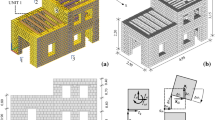Abstract—
Nowadays, many objects are exposed to the risks of seismic activity, either of a natural character during earthquakes or due to man-made hazards. For example, the zone of increased seismic activity includes the eastern regions of Russia located in the zone of the so-called Ring of Fire, the coastal zone of the continents of Eurasia, North America, South America, and Australia, as well as the islands surrounding the Pacific Ocean. Taking into account the development of high-performance computing systems, the investigations into the possibilities of using more precise methods for calculating the seismic resistance of structures to natural and man-made impacts is an urgent fundamental scientific problem, which this study aims to address. The relevant calculations are performed by the grid-characteristic method. Thereby wave fields of the velocity vector and the Cauchy stress tensor were computed. The failure areas of multistory concrete buildings are calculated using the destruction criterion of the main stress. The destroyed areas are subsequently considered as free boundaries within the integration domain. In this study various types of specifications of the initial seismic impact are considered. They are also compared in terms of their impact on the localization of failure areas and the consumption of computing resources. A comparison of the localization of the calculated failure areas of multistory buildings with a decrease in the coordinate step of the computational grid and the time integration step is also performed. We also analyze the dependence of the localization of the calculated failure areas contingent upon the type of specified seismic impact, the type of seismic wave, and the number of floors in the building. The data on the consumption of computational resources for various formulations of problems, including random access memory, hard disk memory, and computation time, are presented.









Similar content being viewed by others

REFERENCES
P. Moczo, J. O. Robertsson, and L. Eisner, “The finite-difference time-domain method for modeling of seismic wave propagation,” Adv. Geophys. 48, 421–516 (2007).
T. Wang and X. Tang, “Finite-difference modeling of elastic wave propagation: A nonsplitting perfectly matched layer approach,” Geophysics 68 (5), 1749–1755 (2003).
R. W. Graves, “Simulating seismic wave propagation in 3D elastic media using staggered-grid finite differences,” Bull. Seismol. Soc. Am. 86 (4), 1091–1106 (1996).
M. Dumbser and M. Käser, “An arbitrary high-order discontinuous Galerkin method for elastic waves on unstructured meshes. I. The two-dimensional isotropic case with external source terms,” Geophys. J. Int. 166 (6), 855–877 (2006).
M. Dumbser and M. Käser, “An arbitrary high-order discontinuous Galerkin method for elastic waves on unstructured meshes. II. The three-dimensional isotropic case,” Geophys. J. Int. 167 (6), 319–336 (2006).
E. Tessmer, “3-D seismic modeling of general material anisotropy in the presence of the free surface by Chebyshev spectral method,” Geophys. J. Int. 59, 464–473 (1995).
H. Igel, “Wave propagation in three-dimensional spherical sections by Chebyshev spectral method,” Geophys. J. Int. 136, 559–566 (1999).
D. Komatitsch, J. P. Vilotte, R. Vai, J. M. Castillo-Covarrubias, and F. J. Sanchez-Sesma, “The spectral element method for elastic wave equations-application to 2-D and 3-D seismic problems,” Int. J. Numer. Methods Eng. 45 (9), 1139–1164 (1999).
G. Seriani, “3-D large-scale wave propagation modeling by a spectral-element method on a Cray T3E multiprocessor,” Comput. Methods Appl. Mech. Eng. 164, 235–247 (1998).
A. V. Favorskaya and I. B. Petrov, “Grid-characteristic method,” in Innovations in Wave Processes Modelling and Decision Making (Springer Switzerland, 2018), Vol. 90, Chap. 7, pp. 117–160.
A. V. Favorskaya, M. S. Zhdanov, N. I. Khokhlov, and I. B. Petrov, “Modeling the wave phenomena in acoustic and elastic media with sharp variations of physical properties using the grid-characteristic method,” Geophys. Prospect. 66 (8), 1485–1502 (2018).
V. A. Biryukov, V.A. Miryakha, I. B. Petrov, and N. I. Khokhlov, “Simulation of elastic wave propagation in geological media: Intercomparison of three numerical methods,” Comput. Math. Math. Phys. 56 (6), 1086–1095 (2016).
M. L. Yaghin and M. A. Hesari, “Dynamic analysis of the arch concrete dam under earthquake force with ABAQUS,” J. Appl. Sci. 8 (15), 2648–2658 (2008).
Y. Xunqiang, L. Jianbo, L. Chenglin, and W. Gao, “ANSYS implementation of damping solvent stepwise extraction method for nonlinear seismic analysis of large 3-D structures,” Soil Dyn. Earthquake Eng. 44, 139–152 (2013).
Z. Nikolic, N. Zivaljic, H. Smoljanovic, and I. Balic, “Numerical modelling of reinforced concrete structures under seismic loading based on the finite element method with discrete inter-element cracks,” Earthquake Eng. Struct. Dyn. 46 (1), 159–178 (2017).
A. Breus, A. Favorskaya, V. Golubev, A. Kozhemyachenko, and I. Petrov, “Investigation of seismic stability of high-rising buildings using grid-characteristic method,” Proc. Comput. Sci. 154, 305–310 (2019).
A. Favorskaya, V. Golubev, and D. Grigorievyh, “Explanation of the difference in destructed areas simulated using various failure criteria by the wave dynamics analysis,” Procedia Comput. Sci. 126, 1091–1099 (2018).
A. V. Favorskaya and I. B. Petrov, “Study of seismic isolation by full-wave numerical modeling,” Dokl. Earth Sci. 481 (5), 1070–1072 (2018).
A. V. Favorskaya, A. V. Breus, and B. V. Galitskii, “Application of the grid-characteristic method to the seismic isolation model,” Smart Innovation Syst. Tech. 133, 167–181 (2019).
A. S. Kholodov and Ya. A. Kholodov, “The construction of difference schemes for hyperbolic equations based on characteristic relations,” USSR Comput. Math. Math. Phys. 9 (2), 158–176 (1969).
Funding
This work was supported by the Russian Foundation for Basic Research, project no. 18-01-00526.
Author information
Authors and Affiliations
Corresponding author
Additional information
Translated by I. Pertsovskaya
Rights and permissions
About this article
Cite this article
Favorskaya, A.V., Petrov, I.B. Calculating the Destruction of Multistory Buildings by the Grid-Characteristic Method. Math Models Comput Simul 12, 897–906 (2020). https://doi.org/10.1134/S207004822006006X
Received:
Revised:
Accepted:
Published:
Issue Date:
DOI: https://doi.org/10.1134/S207004822006006X



